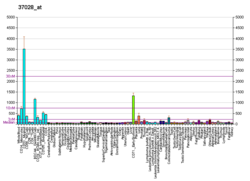Protein phosphatase 1 regulatory subunit 15A, also known as growth arrest and DNA damage-inducible protein (GADD34), is a protein that in humans is encoded by the PPP1R15A gene. [5] [6] [7]
Contents
The Gadd34/MyD116 gene was originally discovered as a member in a set of gadd and MyD mammalian genes encoding acidic proteins that synergistically suppress cell growth. [8] Later on it has been characterized as a gene playing a role in ER stress-induced cell death, being a target of ATF4 that plays a role in ER-mediated cell death via promoting protein dephosphorylation of eIF2α and reversing translational inhibition. [9]





